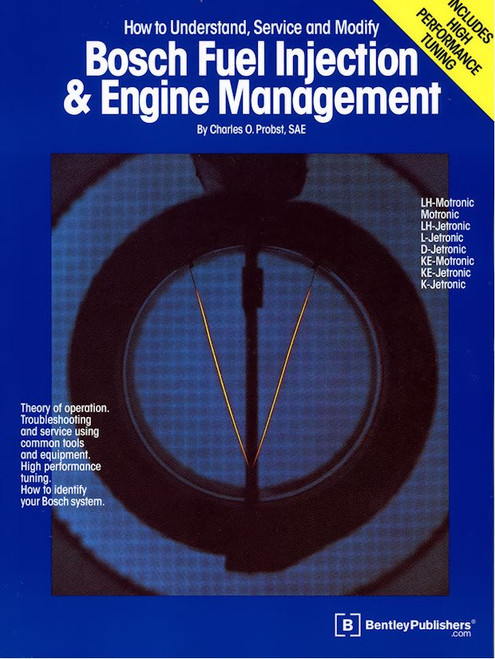Modern engines have become not only more powerful in recent years, but also quite more complicated. As such, the need for in-depth, accurate knowledge has grown considerably. And while engine tuning has always been considered an "art" by many, all engines truly need — to reach their true performance potential — is a balanced combination of air, fuel, and timing. As simple as that. But "simple" does not mean "easy," and that's where Engine Management: Advanced Tuning comes in. This how-to guide takes engine tuning techniques to a higher level, and is required reading for tuners and calibrators, or anyone who wants to extract the most horsepower out of their fuel-injected or electronically-controled engine. The book features practical tuning examples that will help advanced readers use this new information to common engine calibration situations. Author Greg Banish is a mechanical engineering graduate of GMI Engineering and Management Institute who works as an OEM calibrator by day and professional engine tuner in his spare time. He owns a performance shop outside of Detroit.
Book Excerpt: Engine Management: Advanced Tuning FORCED INDUCTION
Subject: Transportation: Automotive: Performance: Engine Management Advanced Tuning. ISBN-10: 1932494421 | ISBN-13: 9781932494426 | CarTech SA135
Book Excerpt: Engine Management: Advanced Tuning FORCED INDUCTION
So far, the focus of the book has been naturally aspirated engine calibration. Although forced induction has been occasionally mentioned, it deserves some more focused attention. The aftermarket performance industry is flush with ways to add power to an engine. Few of these methods come close to the potential that forced induction offers for power increases. Many OEM vehicles are built with superchargers or turbochargers from the factory, which often leaves the door open for the enthusiast to simply increase the pressure ratio in the search for power. At the end of the day, the concerns are the same. Any time more compression happens to a gas, its temperature rises by some amount. How much temperature increase comes along with the compression is a direct result of the amount of compression happening and the efficiency with which it is being done. Not all compression methods are created equal. It is important not to confuse manifold pressure with cylinder pressure. The two are linked, but the relationship between them is unique for each engine combination. Cylinder pressure is the primary deciding factor when considering how much less timing is needed under boost compared to the same engine under atmospheric conditions. Looking at load instead of boost gives a better representation of what the engine wants. Increases in airflow cause load shifts, not boost. Boost is just a measure of restriction between the engine and compressor. If exhaust backpressure or camshaft design is changed to increase flow, boost may actually decrease (without a change in drive/pulley ratio) while airflow and load increase. This condition may require a reduction in timing to prevent knock at the higher load even though boost has been reduced. The only way to know for sure is to test under load. As mentioned before, extra fueling is used to improve combustion stability and reduce temperatures under high load. The increase in available airflow may also require revision to acceleration enrichment requirements to accommodate the higher instantaneous increases in airflow on tip-in. Supercharged engines should still be able to operate normally at low and mid-load. The addition of forced induction alone does not require that the engine always be operated rich.
Subject: Transportation: Automotive: Performance: Engine Management Advanced Tuning. ISBN-10: 1932494421 | ISBN-13: 9781932494426 | CarTech SA135
TABLE of CONTENTS:
- Introduction
- The Basics
- The Good Ol' Days: Carburetion, Timing, Cam Timing
- Taking Measure: Throttle Position, Coolant Temp, Manifold Pressure, etc.
- Outputs: Fuel Injectors, Throttle/ETC/Fly by Wire, Boost Control, etc.
- The "Recipe:" Modeling Airflow, Speed Density, Correction Factors, etc.
- Ignition: Burn Rate
- Data Logging
- Getting Into the Zip Code: MAF Scaling, Spark Advance, etc.
- Settling Down: Dashport
- More Power
- Polishing a Sculpture: Fuel Maps, Spark Maps, Tip-In Ignition, etc.
- Forced Induction: Centrifugal Superchargers, Turbochargers, NOS, etc.
- Conclusion
- Ford Tuning: Examples
- GM Tuning: Examples
- Standalone EFI Systems: Accel DFI, F.A.S.T., AEM, MegaSquirt, Electromotive TEC³r
- INCA OEM Calibration Tool
- External Controllers: VAFC/MAF Adjusters, Hobbs Switches, The FMU, etc.










